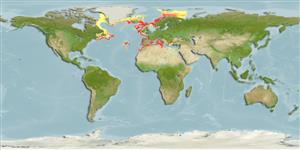Classificação / Names
Common names from other countries
Referência principal
Tamanho / Peso / Idade
Max length : 155 cm TL macho/indeterminado; (Ref. 1371); Peso máx. publicado: 30.0 kg (Ref. 35388); Idade máx. registada: 20 anos (Ref. 1371)
Length at first maturity
Lm 86.5 range ? - 88 cm
Ambiente
; marinhas demersal; não migratória; intervalo de profundidade 150 - 1000 m (Ref. 54594), usually 350 - 500 m (Ref. 54594)
Clima / Intervalo
Temperate, preferred 5°C (Ref. 107945); 79°N - 29°N, 65°W - 44°E (Ref. 54594)
Distribuição
Northeast Atlantic: Southwestern Barents Sea, sometimes north to Spitsbergen, southeastern Greenland, southern coast of Iceland, around the British Isles and south to Morocco and into the western Mediterranean. Northwest Atlantic: Newfoundland.
Países | Áreas FAO | Ecossistemas | Ocorrências | Introduções
Descrição breve
Espinhos dorsais (total): 0; Espinhos anais 0; Raios anais moles: 70 - 81. Lower jaw longer than upper jaw; barbel shorter than eye diameter. Back gray-brown, grading to white ventrally. Posterior portions of vertical fins dark with pale margins.
Categoria na Lista Vermelha da IUCN (Ref. 115185)
Ameaça para o homem
Harmless
Utilização humana
Pescarias: espécies comerciais
Mais informação
ReferênciasAquaculturaPerfil para aquaculturaEstirpesGenéticaFrequência dos alelosHereditariedadeDoençasProcessamentoMass conversion
Ferramentas
Relatórios especiais
Descarregue XML
Fontes da internet
Estimates of some properties based on models
Phylogenetic diversity index
PD50 = 0.6250 many relatives (e.g. carps) 0.5 - 2.0 few relatives (e.g. lungfishes)
Nível Trófico
4.5 ±0.6 se; Based on diet studies.
Resiliência
Baixo, tempo mínimo de duplicação da população 4,5 - 14 anos (K=0.13-0.16; tm=8-11; tmax=20)
Vulnerabilidade
Very high vulnerability (75 of 100)
Categoria de preço
